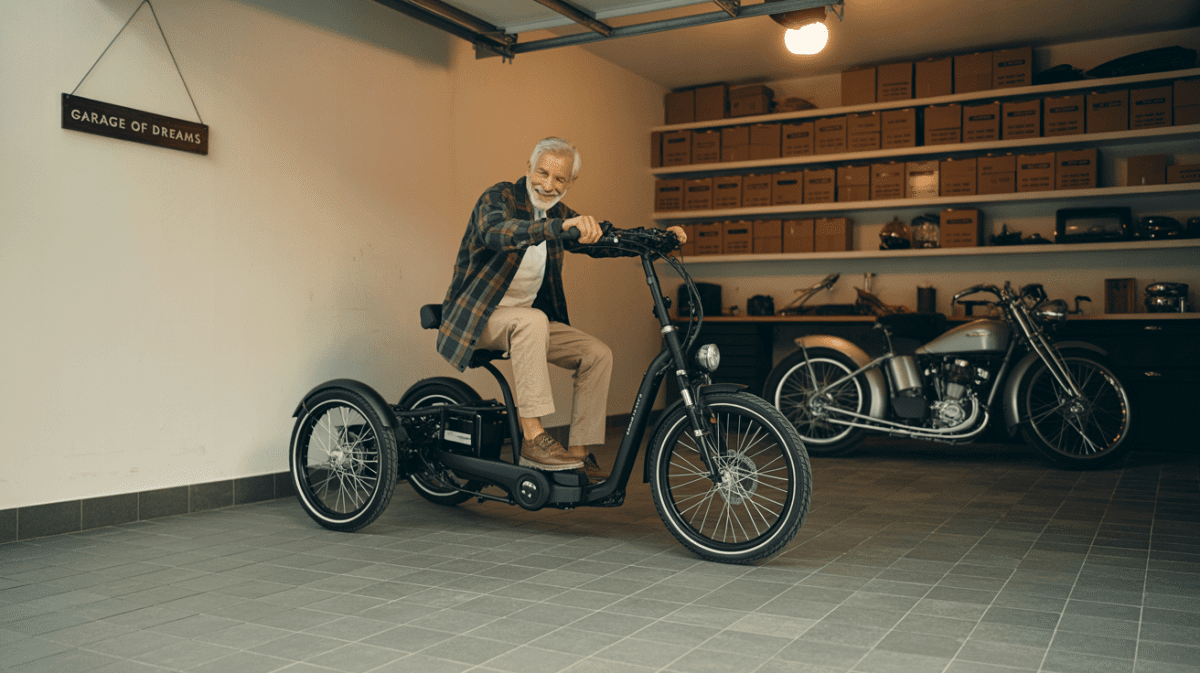Storing your electric trike the right way can make a huge difference in how long it lasts and how well it runs. Whether you’ve got space inside or you’re stuck with the backyard, how you store it matters—weather, moisture, and random hazards can all take a toll.
The best move? Find a dry, sheltered spot that keeps your trike away from wild temperature swings and nasty weather.

No room indoors? A solid cover and a secure spot outside can still go a long way. Prepping your trike before parking it for a while (and knowing what not to do) can save you headaches and cash down the road.
Just a few easy steps make storing your electric trike safer and less stressful. With a bit of care, your trike stays ready for smooth rides whenever you want.
Key Takeways
- Store the electric trike in a dry, sheltered area to prevent damage.
- Proper preparation before storage helps maintain battery and tire health.
- Use covers and secure outdoor storage to protect against weather and pests.
Essential Preparations Before Storing Your Electric Trike

Giving your electric trike a little attention before storing it can save you from nasty surprises later. Start with a good cleaning, get the battery sorted, and check for anything worn or broken.
Cleaning and Maintenance
Before stashing it away, wipe down the frame and wheels with a soft cloth to get rid of dirt and moisture. Skip the pressure washer—water and electronics don’t mix.
Lubricate the chain and gears to keep rust at bay and everything running smooth. Give the brakes and tires a once-over and fix any issues you spot.
Dry the trike thoroughly after cleaning to dodge corrosion. If you have to store it outside, a waterproof cover is a must for rain and dust.
Battery Care and Storage
The battery’s the heart of your trike, so treat it right. Charge it to somewhere between 50% and 70% before storage—don’t leave it dead or fully juiced.
Keep the battery in a cool, dry spot, away from sun and temperature extremes. Freezing temps can really mess with battery life, so avoid that.
If you can, pull the battery out before storage. Every few weeks, check the charge; if it dips below 30%, top it up so it doesn’t get damaged.
Routine Inspections
Regular checks—before and during storage—can catch problems early. Look for cracks or rust on the frame, and check tire pressure and for any flat spots.
Test the brakes, lights, and all the electronics. Swap out or repair worn parts quickly so small issues don’t turn into big ones.
Indoor Storage Solutions for Maximum Protection
Storing your electric trike indoors is the safest bet for avoiding damage and theft. Good airflow in your storage spot also helps keep things dry and working.
Choosing the Right Indoor Location
The best indoor spot is dry, clean, and secure. Garages, basements, or a dedicated bike room work great—just keep the trike away from chemicals, since those can wreck batteries and metal parts.
Don’t store near anything flammable. Make sure the area’s well-lit and locked up to boost security.
Set the trike on a smooth surface to avoid tire issues. If you’re tight on space, a sturdy stand or wall mount keeps it upright and out of the way.
Climate Considerations and Ventilation
Temperature swings and dampness are bad news for electric trikes. Try to keep the area at a steady 50–70°F (10–21°C) to protect the electronics and battery.
Ventilation helps stop rust and mold. Even a small fan or vent can keep air moving and dust from settling.
Skip damp basements or anywhere that feels clammy. If you notice moisture, a dehumidifier can help.
Check the storage environment now and then to catch any problems early.
Best Practices for Outdoor Storage and Weatherproofing
Storing outside? You’ll need to get serious about protection. Good covers, solid locks, and smart moisture management are all non-negotiable if you want your trike to survive the elements.
Selecting Durable Covers and Shelters
Pick a quality outdoor cover that’s waterproof and lets air circulate. Moisture trapped under cheap, flimsy covers leads to rust and electrical problems.
If you can swing it, set up a small shed or shelter with a roof for extra defense against rain and sun. Always park the trike on solid, flat ground—concrete beats soggy grass every time.
Securing Against Theft and Damage
Lock up your trike with a tough lock system. A heavy-duty U-lock plus a cable lock is a good combo. Make sure you secure both the frame and wheels to something sturdy.
If possible, keep your trike in sight of neighbors or a camera. Don’t leave keys or controls out in the open. Check your locks and look for tampering every so often.
Managing Exposure to Elements
Don’t park on mud or grass—ground moisture speeds up wear. Cover the whole trike with a tarp, especially in rain or snow.
Take the battery out and store it inside if you won’t be riding for a while. Ideal battery storage is indoors at 32°F to 70°F. Wipe down the trike now and then to keep dirt and dampness away.
Regular Use, Access, and Long-Term Care
Keeping your electric trike in shape means balancing regular rides with smart storage. You’ll also want to tweak your routine as the seasons change.
Balancing Storage With Frequent Riding
If you’re riding often, stash your trike somewhere easy to grab maybe a garage or shed close to the door. Charging the battery after each ride ensures it's always ready to go.
Give the trike a quick clean regularly to stop grime from causing problems. Even indoors, a cover keeps dust and moisture off.
Before commencing your commute, check your brakes and tires for any issues. Lubricate cables and moving parts, but don’t go overboard—too much oil just attracts more dirt.
Preparing for Seasonal Changes
When it gets cold, indoor storage protects the battery from freezing. If you’re not using the trike for weeks, keep the battery at about 50% charge.
Stuck with outdoor storage? Grab a waterproof cover and secure it tightly. Raise the trike off the ground and clean it before putting it away.
For extended breaks, remove the battery and store it separately in a cool, dry location. That helps it last longer and avoids damage from temperature swings.
| Task | Recommended Action |
|---|---|
| Battery during storage | Keep 40-60% charged, store indoors |
| Cleaning before storage | Remove dirt, dry completely |
| Protecting outdoors | Use a waterproof cover, raise it off the ground |
| Easy access storage | Garage or indoor shed near the door |
Frequently Asked Questions
Rain, sun, and cold can all affect your electric trike if you don’t prepare it properly. The right cover, a bit of cleaning, and a smart storage spot can save space and prevent damage. Security matters too, whether you’re storing inside or out.
What is the best way to protect an electric trike from weather elements when stored outdoors?
A snug, waterproof cover keeps rain and dust off your trike. Use bungee cords or rope to tie it down so it doesn’t blow away. Bringing the battery inside during rough weather helps it last longer.
Are there specific storage covers recommended for electric trikes?
Opt for water-resistant or waterproof covers specifically designed for electric bikes or trikes. Ventilation is important—otherwise, you’ll get rust or mold. Avoid thin, plastic covers that just trap moisture.
What are the crucial steps for preparing an electric trike for long-term storage?
Switch off the power and lights to conserve battery power. Clean and dry the trike fully before putting it away. Remove the battery and store it in a cool, dry place. Inflate the tires to the recommended pressure.
How can I maximize space when storing my electric trike indoors?
Keep the trike near a wall or in a corner to free up floor space. Try hooks or wall mounts to lift it off the ground. If your model allows, folding or removing pedals can also be helpful.
Can storing an electric trike on its side cause any damage?
Could you not do it? Storing a trike on its side can lead to oil or battery leaks and more mechanical problems. Always park it upright, on its wheels or on a proper stand.
What security measures should be taken when storing an electric trike outside?
Secure the frame and wheels with a sturdy lock and attach it to a solid object. Store your trike in a lockable storage box or shed, if possible.
Pick a well-lit spot that’s easy for others to see. Thieves tend to avoid attention, so parking in areas with people around helps keep your trike safe.
Disclaimer
This document is provided for general information purposes only and should not be relied upon as providing legal advice, technical, or specific operational guidance to the reader, whether as to the practices described in the document or the applicable legal requirements and regulations. Senior Trikes.com expressly disclaims any responsibility for liability arising from or related to the use or misuse of any information in this document.



